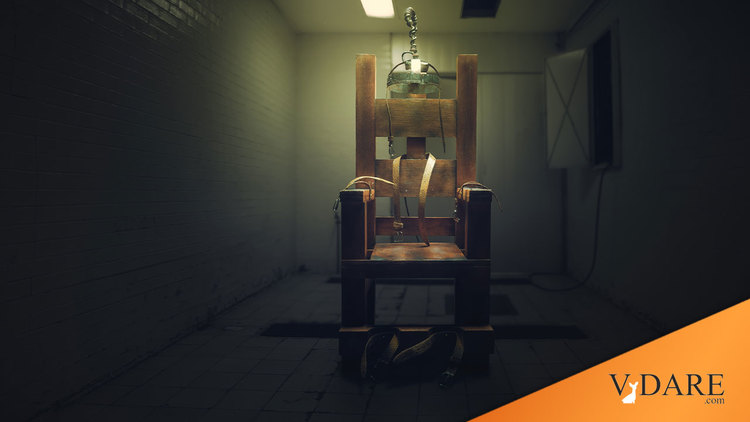


By Sam Francis
06/18/2001
Less than a week before Timothy McVeigh entertained the nation with a dose of the hot juice, a beaming Attorney General John Ashcroft popped up before the House Judiciary Committee to announce that a new Justice Department study shows there is "no evidence of racial bias in the administration of the federal death penalty." Since the media have spent much of the last year claiming that capital punishment is unfair, ineffective, and biased, that announcement in itself should have been major news. It wasn’t. The Washington Post stuck it on page 28 of its front section; The New York Times was only one page better, hiding it at the bottom of page 27.
Since one of the main arguments against the death penalty these days is that it is unfairly applied to non-whites more than whites, any study claiming to show that’s not true can’t be used for the abolitionists' purposes. Therefore you stick the stories about it in the back pages. Nevertheless, the truth, like murder itself, will out.
The Justice Department study, authorized by Attorney General Janet Reno and conducted mainly under the Clinton administration, shows that in 973 potential capital cases the Reno Justice Department (including U.S. attorneys who operate at the state level) sought the death penalty for 27 percent of whites, 17 percent of blacks, and 9 percent of Hispanics. The numbers show that federal authorities seek death for white defendants more than for non-whites, but that still doesn’t satisfy the critics.
In a hearing last week, Sen. Russell Feingold of Wisconsin demanded of Deputy Attorney General Larry Thompson, "How did we wind up with 90 percent of the people on death row minorities?" The question illustrates what’s wrong with how the critics think about the death penalty and its application.
Sen. Feingold might as well ask, "How did we wind up with so many more men than women on death row?" The answer is that many more men than women commit capital crimes. The same answer probably explains why non-whites are over-represented in the death house as well.
"Probably" because without a case-by-case study, no one can know for sure, even with the study released by Justice. But the data offered by Mr. Ashcroft suggests — as common sense ought to tell us — that there’s no racial bias against non-whites involved.
Thus, in cases in which U.S. attorneys could have sought the death penalty on the basis of the facts of the case as opposed to cases in which they actually did seek death, the study showed that they sought the death penalty in 81 percent of cases where defendants were white but only 79 percent where defendants were black and 56 percent where they were Hispanic. The possibility is that there might be a slight bias against whites.
But then it doesn’t really matter what this or any other study says, since the passion to get rid of the death penalty exists independently of the facts. Thus, David Bruck, a lawyer and death penalty foe who also testified before the Senate last week, claimed that "we just don’t know" if there is a racial bias in the penalty’s application or not. And since "we just don’t know," he concluded, "let’s call a halt" to capital punishment.
But the fact is that we do know, as much as human beings can ever know much of anything. We know that non-whites, for whatever reason, commit far more murders and other violent crimes than whites, and therefore it makes sense that there will be more non-whites convicted of such crimes and that more will be sentenced to death than whites.
We know the judicial processes by which guilt is determined are today painstakingly slanted in favor of non-white defendants. We know the prosecutors appointed by the Clinton-Reno Justice Department were not exactly arch-reactionary bigots determined to drag blacks and Hispanics to the nearest gallows.
Most of all, we know the men now on death row, no matter what race they are, were convicted in accordance with legal norms and have a virtually inexhaustible series of appeals by which to challenge their convictions. McVeigh himself was executed so quickly only because he abandoned his appeals; the average time between sentencing and execution is closer to twelve years.
"We cannot in good conscience put people to death," Sen. Feingold intoned last week, "until we are confident in the fairness of the system that leads to these decisions." He’s right the system should be fair; there’s really very little to indicate it isn’t, but whether it is or isn’t, we can and should execute murderers whose guilt is beyond a reasonable doubt, because just to "call a halt" is to deny the justice that enemies of the death penalty claim to be so worried about.
COPYRIGHT 2001 CREATORS SYNDICATE, INC.
June 18, 2001